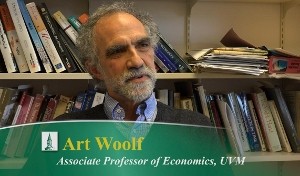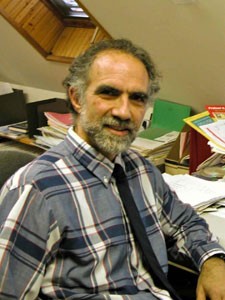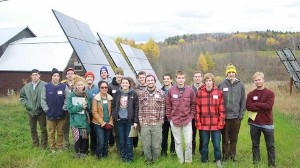Vermont’s aging population, low birth rates and shrinking work-force have drawn the attention of policy-makers and citizens. The changing demographics will have profound impacts on the state’s economic and social structures.
UVM Economics Professor Art Woolf has been studying the issue for years, presenting the first warnings in the late 1990s and continuing to explore the changing demographics and implications for the state since.
See our brief video with Art Woolf.
Dr. Woolf joined the Economics Department at UVM in1980 after receiving his Ph.D. in economics at the University of Wisconsin in Madison. Starting in 1988, Dr. Woolf spent three years as the State Economist for Governor Madeleine Kunin — where he worked first-hand applying economic principles to public policy issues. Dr. Woolf has continued to engage with state policy as a writer, economist and frequent commentator (see his columns in The Burlington Free Press and his commentaries and interviews on Vermont Public Radio).
The Center for Research on Vermont sat down with Art Woolf to discuss changes in Vermont’s demographics.
CRVT: What can you tell us about the issue of Vermont’s changing demographics?
Woolf: One of the issues that I became aware of ten or fifteen years ago, was Vermont’s changing demographics, and by that I mean it’s changing age structure. It was pretty apparent to me by looking at the numbers that Vermont was aging much more rapidly and we were not growing as fast in terms of overall population as most other states. In fact we were down near the bottom in population growth, up near the top in the growth of the older population, and I thought that was going to have some very serious ramifications on the state economy and on the way we live over the next 20 years or so. That was maybe ten years ago or more, and it’s now pretty obvious to everyone that our demographics are very different from the nation and most other states. And this process is going to continue to unfold for at least the next fifteen years and probably beyond that.
CRVT: What are some of the implications of these findings?
Woolf: In fifteen years, roughly 1 in 4 Vermonters will be over the age of 65. Obviously that means that there’s not as many people working or available to work. And people who are retired don’t earn as much as people who work. So we have two things to think about: number one, where are employers in Vermont going to get their workers if the working age population—people between 18 and 65—is declining? And the second thing is, if people over 65 tend not to earn as much as people under the age of 65, because they’re relying on their retirement income and social security, what’s going to happen to state tax revenue growth, especially income taxes? They’re not going to go down to zero, but the projections of tax revenue growth have to be predicated on a certain number of people working and earning an income.
So the state is going to be under some serious financial pressure, and we’re already seeing that now for the upcoming budget for the legislature that meets in 2015. The fiscal year 2016 state budget has a $100 million projected shortfall. Part of that, not all of it, but part of that is due to the decreasing number of workers in Vermont, and that’s going to be a continual problem. On the other hand, the private sector is going to have a hard time finding qualified workers, and it’s not just qualified high-skill workers, it’s qualified semi-skilled workers, and qualified unskilled workers. We’re going to be seeing a lot of “Help Wanted” signs all over the place, and it’s going to be a concern for Vermont employers.
CRVT: Is there any variation in this pattern in parts of the state?
W: If we look at the state as a whole, this demographic change is playing out differently and will play out differently in the future. First of all, greater Chittenden county is doing relatively well compared to the rest of the state. It’s still not doing as well as the nation as a whole in terms of population and number of young people, but it’s better than the rest of the state, which means there have to be some parts of the state which are not doing very well in terms of this demographic change that’s occurring. That’s especially true for the four southern counties of the state, where the total population, not just the working age population, is less today than it was in 2000.
CRVT: What suggestions do you suggest.
Woolf: I think what we need to do to reverse this demographic decline is try to make Vermont a very inviting place, not only for people of any age to come, but especially for businesses to come or to expand. And the two of them are going to work together. If there are more people businesses are going to be more likely to locate here because there are people as customers and as workers. People are the prime resource for any business. And if there are more businesses here, people are more likely to move here to work for them. It’s a double-edged sword, and we need to figure out how to keep both edges sharp.





Recent Comments